|
|
Location: Yorkshire, UK
Joined: Aug 2010
Posts: 877
|
10-08-2010, 12:53 PM
A rough BARF guide
I've posted this guide on a couple of forums now, there are photos of how to prepare meat, so be warned if you're squeamish.This is the diet I've developed for my dogs over the last couple of years, which has evolved a little, to include green tripe, and also shows the amounts of veg plus the additives I put in their food, and explains what they are used for.
I personally don't think there is one right way to raw feed, but as long as you give your dog a wide range of fresh good quality food that it can derive the nutrients it needs, then you won't be going far wrong. So, this is my rough barf guide, I hope people will add in what they feed, and why......
First up is the selection of vegetables, which can be anything really, with a mix across the range of root, leaf and pulse. I was outside doing this as it was warm enough, and Indie and Tau got the occasional treats chucked their way. The only couple of things to avoid are broccolli and onions, although mine do occasionally get bits of broccolli that are left over, I don't buy it specifically to put in their veg mix.
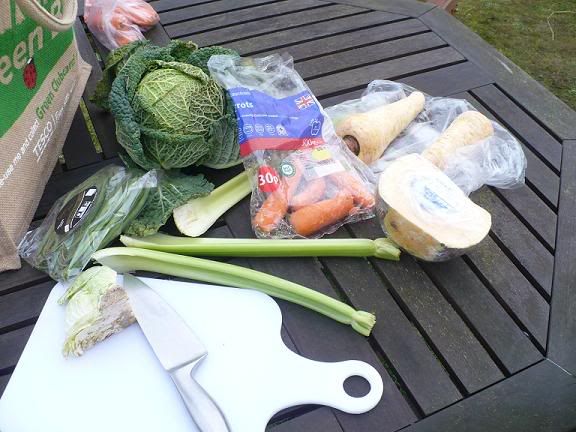
Carrots are a useful source of vitamins A, B1, B6, C and K.
Cabbage (dark green like savoy) are a useful source of vitamins B1, Folate and C, along with Sulphur.
Swede is a useful source of vitamins B1, B6, Folate and C.
Parsnips are a useful source of vitamins B1, B6, Folate, C, along with Potassium and Phosphorus.
Green beans are a useful source of vitamins A, Folate and C.
Other things I put in there are:
Cauliflower is a useful source of vitamins B1, B6, C and K, along with Potassium.
Spinach is a useful source of vitamins A, B6, Folate, C and K, along with Calcium, Iron, Phosphorus, and Magnesium.
Sweet Potato is a useful source of vitamins A, B1, B6, C and E, along with Potassium.
Tomato is a useful source of vitamins A, B6 and C.
I do sometimes put apple, banana or pear into their veg mix, and are good sources of vitamin C, B6 and C, along with Potassium and Magnesium.
I chop them all up and put them into one of those hessian bags ready to blend:
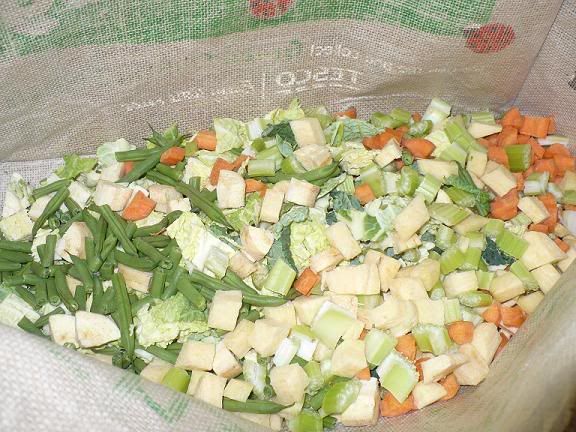
The nuts are in there because they have a good mix of vitamins and minerals, so I put a good size handful in there (along with a couple of cloves of garlic):

Almonds - B vitamins, E / Calcium, Copper, Iron, Potassium, Magnesium, Phosophorus and Zinc
Brazils - B1, B6 / Calcium, Copper, Potassium, Magnesium, Phosphorus, Sulphur, Selenium and Zinc
Cashews - B1, B6 / Copper, Iron, Potassium, Magnesium, Phosphorus, Sulphur, Selenium and Zinc
Hazelnuts - B1, B6 / Calcium, Potassium, Magnesium, Phosphorus, Sulphur and Zinc
Peanuts - B1, B6, Folate and Niacin / Copper, Magnesium, Phosphorus, Sulphur and Zinc
Pecans - B1 / Copper, Magnesium, Phosphorus, Sulphur and Zinc
Walnuts - B6 / Copper, Magnesium and Phosphorus
Garlic has two ‘medicinal’ ingredients, Allicin and Diallyl Sulphides. Allicin is active once garlic is chopped or crushed, and is linked to anti biotic and anti fungal properties. Diallyl Sulphides is linked to improving blood and circulation, again, it is more effective when chopped/crushed.
The other things that go into their food are one capful of apple cider vinegar, and a level teaspoon of turmeric. Apple cider vinegar is linked to healthy bones, and helps fight against osteoperosis, containing manganese, magnesium, phosphorus, calcium and silicon. It is also an anti-cancer agent containing beta carotene and phytochemicals that help in cancer prevention. Turmeric has been linked to anti inflammatory, anti bacterial, and liver and heart protecting effects. It is used to used to ease joint pain, and inflammation associated with arthritis, and is a good source of antioxidants.

Finally, they also get a couple of tablespoons of oil mixed in, in this case, I’ve reserved oil that I used to make a confit previously, so it’s got bits of meat in there, yum!!
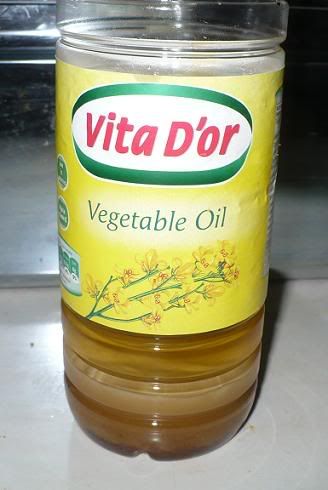
So this is it, all in a mixing bowl…
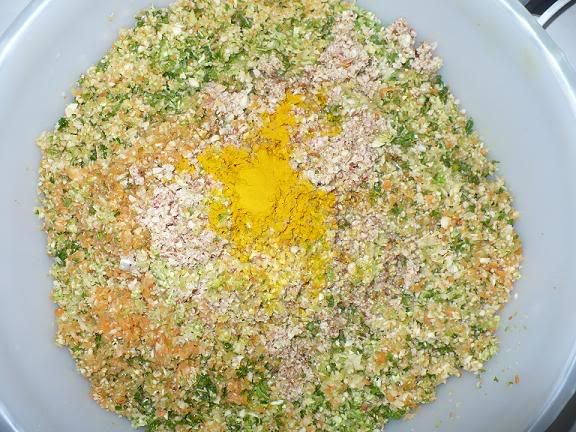
And once it’s all blended, and mixed in, I use left over plastic take away tubs, and freeze it. Then I cut off approx one quarter to mix in with their breakfast, and leave it to defrost while I take the girls on their morning walk.
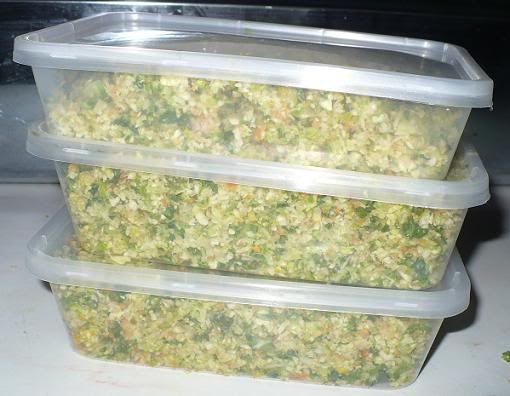
So what do these vitamins do?
Vitamin A – vision, bone growth, reproduction and health of skin, also acts as an antioxidant.
Vitamin B1 – also known as thiamin, helps convert carbohydrates and fats into energy. Cannot be stored in the body, but once absorbed, it is concentrated in muscle tissue.
Vitamin B2 – also known as riboflavin, necessary for the release of energy from carbohydrates, and for normal growth and development.
Niacin – necessary for production and breakdown of glucose, fats and amino acids, development, maintenance and function of the skin, intestine and stomach, as well as the nervous system, and in manufacturing dna.
Pantothenic acid – a b-complex vitamin, also known as B5, helps break down proteins, and their amino acids, fats and carbohydrates enabling the production of energy.
B6 – also known as pyridoxine, involved in the production and digestion of amino acids, and helps the body manufacture the hormone insulin. It is involved with anti bodies that fight infection, and certain chemicals that send messages between nerve cells, as well as in the production of histamine.
Vitamin B12 – also known as cyanocobalamin or cobalamin, I sreleased from food in the stomach, and has to bind with a protein called intrinsic factor to be able to be absorbed by the body. It is necessary for normal growth and development.
Biotin – a b-complex vitamin, essential for converting proteins, carbohydrates and fats into forms the body can use.
Folate – another b-complex vitamins, plays a vital role in the substance that makes up our genes, working with vitamin B12 to form haemoglobin, and converting the amino acid homocysteine to methionine.
Vitamin C – also known as ascorbic acid, is the least stable of vitamins and destroyed by processing, essential for the formation of collagen, an important structural protein that strengthens bones and blood vessels.
Vitamin D – a fat soluble vitamin that has an essential role in the absorbption and use of calcium.
Vitamin E – one of natures most effective antioxidants, and protects the body against free radicals.
Vitamin K – an essential component in the body’s normal blood clotting process.
Calcium – the main mineral present in bones and teeth.
Magnesium – plays a vital role in the formation of bones, teeth, and with the minerals calcium, sodium and potassium, is involved in transmitting nerve signals.
Phosphorus – essential for bones and teeth.
Potassium – together with sodium and chloride potassium is involved in controlling the amount of water and maintaining the correct acid-alkali balance in the body.
Sodium – vital for controlling the amount of water in the body, maintaining normal pH of blood, transmitting nerve signals and helping in muscular contraction.
Sulphur – plays a key role in the manufacture of amino acids and in the conversion of carbohydrates to a form that the body can use.
Chromium – works with insulin to help bind it to it’s receptors.
Copper – plays a key role in several body function, including production of pigment in skin, hair and eyes, production of healthy bones, teeth and heart, and the protection of body cells from chemical damage.
Iodine – associated with thyroid function.
Iron – an essential mineral in all cells, although only needed in small quantities, is a component of haemoglobin, the oxygen carrying protein in red blood cells.
Selenium – is an antioxidant and part of an enzyme that protects cells from the damaging effects of free radicals.
Zinc – needed in minute amounts, essential for the breakdown of carbohydrates, fats and proteins, in normal cell division, growth and repair.
Hope that helps explain the role of the veggies, and in combination with the meat and offal, it provides an important role I feel in a BARF diet.
The Meat Part (LAST WARNING, DO NOT SCROLL DOWN IF YOU DON'T LIKE SEEING RAW MEAT PREPARED)
I have only put in a bit of information about tripe from a useful tripe website, as I have included a link at the end, where you can read in full about the nutritional value of each of the raw meats, and the link also contains a very useful table showing how the vitamins and minerals are used.
First up is tripe, which mine get for breakfast approximately five times a week.
Green Tripe (not the bleached white stuff from the butchers)

Tripe is the stomach of ruminating animals. These animals (i.e. cattle, buffalo, sheep, deer, goats, antelope, etc.) are classified as being four-footed, hooved, cud chewing mamals with a stomach that consists of four chambers. The four chambers of such a stomach are known as the rumen, reticulum, omasum and the abomasum. The food the animal eats (i.e. grass, hay) is swallowed unchewed and passes into the rumen and reticulum where it is then regurgitated, chewed and mixed with saliva. It is again swallowed and then passed through the reticulum and omasum into the abomasum, where it is then further broken down by the gastric juices, amino acids and other digestive enzymes.
In an analysis of a sample of green tripe by a Woodson-Tenant Lab in Atlanta, Georgia, it was discovered that the calcium
The tripe I get comes in 2lb bags, which I split between my two for breakfast, and mix in their blended veggies.
Raw Heart (Lamb or Beast (Beef))
I buy a mix of beast and lambs hearts, and chop it up and bag in portion sizes. They either get it as a meal on it’s own, or I use it over a couple of days adding bits in to their other food. The meat has a texture like steak, and it doesn’t smell like liver, kidneys or other offal.
A whole heart

This shows the texture of the meat

And here it is bagged up and frozen
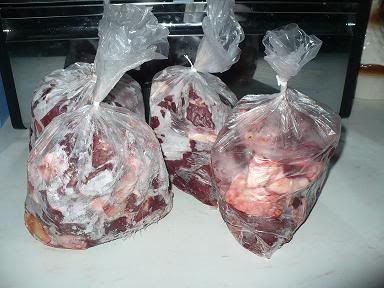
Raw Lamb Bones
I get free bones from my local butchers, and they usually come supplied as whole rib cages. If you’re squeamish, and don’t like seeing how to take apart a carcass, don’t scroll down.
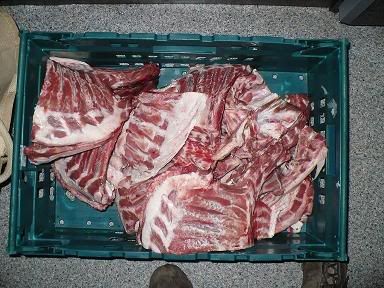
You will need a good pair of poultry shears and a sharp, small knife to make it easy to take the carcasses apart, first off, use the poultry shears to cut along the bottom of the ribs, about 2-3 inches in width.

From the back of the rib cage, where the ribs are longest, count two or three ribs in (depending on the size, for larger count three ribs in) and slide a knife down inbetween the third and fourth rib, making sure you cut right down to the backbone. Hold down the other rib cage from inside, and pull the three ribs back from the carcass, they should dislocate and tear away fairly easily. Do the same for the other side, although it isn’t as easy without having the full rib cage to pull against, it shouldn’t be too difficult.
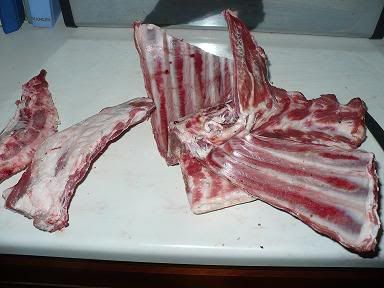
Using the sharp knife, place the lamb bones resting upright on the ribs that are left, with the neck in your left hand, and cut down in front of the first dorsal bone on the rib cage. Then push down hard so that the neck part separates from the back, cut around the sides and base to separate any muscle tissue left on there, and pull apart.

From one rib cage you should end up with nice neat pieces like this.
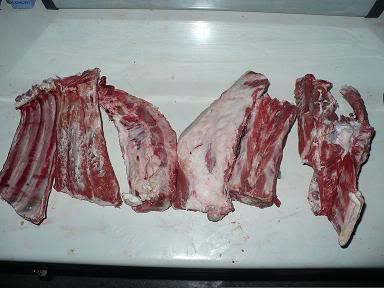
I would feed the neck/back parts each as one meal, and depending on the size fatty rib cage bottom, possibly include the ribs broken away as one meal – so out of that one rib cage there should be enough for four meals as follows – neck; back with small ribs; fatty rib cage with three ribs x 2
I use bones mainly for their evening meal, which they get at around 5pm, and they absolutely love them!!
The chicken they get is either chicken carcasses stripped of most of the meat, one and a half carcasses, which has the breast and about half of the backbones is enough for one meal; or else I get chicken wings, the last two digits, six of which make enough for one meal. Fortunately I don’t have to chop chicken up, but do usually have to pay for it, and depending on whether I get it from the butchers or another supplier, there is more meat on the carcasses, and so the price varies between approx £2.50 to £5 for a large box.
Liver
I use lambs liver, and along with tinned fish, this is the only meat I don’t feed raw. Liver can be high in vitamin A, and I have found in the past it can make mine loose, and so I cook the liver, either in water, or in goats milk. They still absolutely love it, and it has good nutritional value for them.
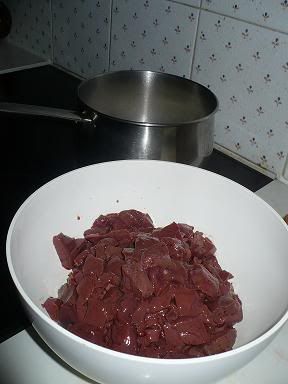
Tubbed up and ready to freeze, one tub is fine split between two, and if needs be, I’ll add a bit of something else if I think it isn’t quite enough
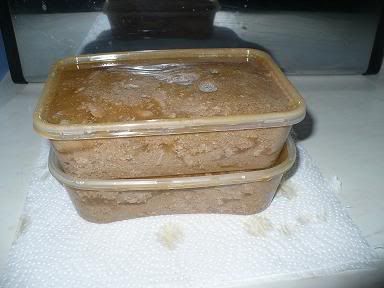
I also feed mine tinned fish in tomato sauce, or oil, simply adding a 125g tin shared between the two, once or twice a week. You can feed fish raw, but I have found with my two that it doesn’t always suit them, and they end up bringing it back up half the time.
I also give them lambs kidneys, which I have found fine to feed raw, and I add them as part of a meal, usually with something like beast heart.
They get a whole raw egg, once or twice a week, shell and all, and they also get any shells left over from cooking.
I don't use pork bones, because you need to be sure of the source so that they are free from internal parasites. Nor do I feed many beef bones, just the occasional marrow bone as a treat for half an hour or so, because they are much more dense, and wear the teeth down that much quicker.
This link saves me quite a bit of typing, and gives the nutritional values for a variety of raw meats, and shows the vitamins and minerals they provide, as well as telling you how they are used.
Useful articles about the nutritional value of raw meats
That's how I use the meat part of the BARF diet, I know others might do it differently, but after feeding my two from pups, and making a few additions and changes along the way, I'm happy with the variety and amounts they get and am glad I don't feel the need to use any fillers. As before, if anyone wants a copy of the BARF sheet I use, please feel free to pm me and ask, it's drawn up from what I've read and experienced. It would be good if others who feed can add bits about their experiences as well, and any thing they do differently.
Typical menu for my Labradors:
For adult Labs:
Monday
Breakfast - 1lb green tripe, 40g blended veggies
Tea - 300-400g chicken carcasses & 125g tinned sardines
Tuesday
Breakfast - 1lb green tripe, 40g blended veggies
Tea - 300-400g chicken carcasses
Wednesday
Breakfast - 250-400g chicken carcasses, 40g blended veggies
Tea - 250g liver cooked in goats milk, 150g chicken carcasses
Thursday
Breakfast - 1lb green tripe, 40g blended veggies
Tea - 300-400g chicken carcasses
Friday
Breakfast - 1lb green tripe, 40g blended veggies
Tea - 300-400g chicken carcasses
Saturday
Breakfast - 250-400g chicken carcasses, 40g blended veggies
Tea - 250g beef/lambs heart
Sunday
Breakfast - 1lb green tripe, 40g blended veggies
Tea - 300-400g chicken carcasses
Where ever I use chicken carcasses, I interchange with lamb bones as well. I also give other food regularly, such as a whole raw egg, cottage cheese, natural yoghurt, and any appropriate left overs. Mine aren't wheat intolerant, so anything like the odd bit of stale bread, left over pasta etc gets thrown their way, not that there's much in my house!

|
|
|
Location: Yorkshire, UK
Joined: Aug 2010
Posts: 877
|
10-08-2010, 04:44 PM

|
|
|
Location: East Midlands, UK
Joined: Mar 2006
Posts: 8,775
|
10-08-2010, 05:43 PM
I actually rather enjoy preparing large quantities of veggies, meat and bones for the freezer. I don my apron, clear the kitchen surface so that it is free of anything that might be polluted by meat spatter and get cutting. I feel very earth-motherish whilst I am doing it, and then have a massive clear-up and sterilisation afterwards. Most satisfying, like making jars of home made pickle, jam etc.

|
|
|
Location: East Midlands, UK
Joined: Mar 2006
Posts: 8,775
|
|
|
Location: Motherwell, UK
Joined: May 2009
Posts: 17,088
|
|
|
Location: West Sussex UK
Joined: Jan 2010
Posts: 2,044
|
11-08-2010, 09:07 AM

|
 |
«
Previous Thread
|
Next Thread
»
| Currently Active Users Viewing This Thread: 1 (0 members and 1 guests) | |
|
|








